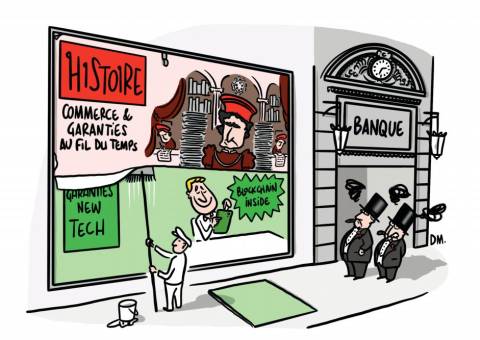Banks capital growth accelerates: After rising +15% in 4 years, from 2009 to 2013, the capital of European banks increased a further +10% over the first 9 months of 2014, or +300 billions euros since 2009 to reach 1.26 trillion in September 2014, the last known figure. As for the major US banks, they have doubled their capital between late 2009 and mid-2013, to 800 billion dollars.
And that's not all: in November 2014, the G20 in Brisbane has decided to reinforce the rules of capitalization for SIFIs. Their solvency ratios will have to reach 16% to 20%, which will then be complemented with specific cushions to be defined by the Council of Financial Stability before the end of 2015. These new rules will apply as of January 1st, 2019. BNP Paribas, SocGen and HSBC have published their estimates of the extra capital required: almost one hundred billion
Obviously, this exponential growth is not sustainable; it looks very much like a flight forward. What will it cost?
In the wonderful world of Modigliani and Miller...
Can banks be made more robust at no cost? Apparently, the answer is yes, according to the theory developed by Franco Modigliani and Merton Miller (MM), two MIT professors who received the Nobel Prize in 1985 for one and in 1990 for the other. They demonstrated that, under certain assumptions, the value of an economic asset is indifferent to the mix of its funding structure. In other words, banks can hold more capital without reducing their own values. The reasoning is quite straightforward: if the capital of a bank increases, all other things being equal, its risk level is reduced. As a result, both its cost of capital and its cost of debt decrease. Ultimately, MM showed that for both the customers, the bank and its shareholders, increasing the share in capital in the bank's refinancing mix has no impact.
To fix this idea, let’s consider a bank that triples its capital:
- At first, its cost of debt is 5% and its cost of capital is 10%. It funds its transactions with 92% of debt and 8% of capital. So, its average cost of refinancing is 5.4% = 92% * 5% + 8%* 10%.
- Then, its share of capital triples to 24%. One might think that, as the cost of capital is higher than the cost of debt, the average cost of funding will grow. In fact, it doesn’t. The reason is that, as the bank holds more capital, it is less risky. So its cost of capital decreases, let’s say from 10% to 8.4% and its cost of debt too, to a lesser extent, from 5% to 4.45%. The average cost of funding of the bank remains at 5.4% = 76% * 4.45% + 24% * 8.4%.
So it is true that, in the wonderful world of MM, banks can be made stronger by increasing their capital without any cost to the bank, its shareholders, its customers and the economy in general. Many regulators, analysts and legislators have stopped at that stage, considering that the impact of the underlying assumptions will only be marginal at worst: What a mistake!
Facing reality
To be able to demonstrate their proof, MM imagined a world without tax, without transaction cost and embedded in an efficient market. These assumptions may hold in a normal context, but they become unacceptable in the highly regulated environment of today's banks. Let’s review them.
Tax effect appears because the interests on debt are tax deductible, as dividends are not. This raises the cost of refinancing when the share of capital increases, except if the tax differential is returned to banks such as in Belgium, where issuing bank capital enjoys a tax advantage. Otherwise, with let’s say, a taxation level of 33%, the average cost of refinancing of our bank increases from 5.4% to 5.8%.
Also, transaction costs cannot be neglected considering the conditions in which the banks are raising their new capital: the increases are massive, at least a doubling over a period of 5 to 7 years. Some new capital comes from retained dividends, but what is left to issue in the markets remains very high. Unfortunately, it appears that there is a shortage of investors willing to invest in banks, as evidenced by the abnormally low value of bank shares, blocked since 2008 below their book values: this means that investors anticipate losses. This increases the cost of capital.
On the issue of market efficiency, the paradox is precisely that they are very efficient because they incorporate all the information available about the changes of a given sector. At first glance, the increase of banks capital appears to reduce their risk, so their cost of capital is likely to decline. But markets show the reverse: the banks cost of capital in fact increases by about 0.1% for each incremental percent of bank
And in fact, this makes sense as there are at least three factors which increase the perceived risk: the gradual disappearance of the implicit State’s guarantee, the elimination of the discount associated with information asymmetry and the risk of "stupid" investments fleeing the regulatory hammer.
- The implicit State’s guarantee is a "moral hazard" that reflects the use of the taxpayer’s money to save Too Big To Fail banks. Its termination is at the heart of prudential objectives: in particular, increasing capital levels aims at shifting the risk to shareholders. But due to a
- What is the discount expected by investors when they participate in a capital increase? It reflects an asymmetry of information: the idea is that the management of a bank that sells new shares is always better informed than the investor in the real value of these securities. They would not put them for sale had they consider them undervalued, would they? Thus, if there is a sale, the price is probably overvalued. Investors therefore expect a discount on the official selling price. But if the issuance is forced, like constrained by regulation, management has no longer its say and the above reasoning falls: there is no more discount opportunity. The cost of selling the capital rises. This increases the cost of capital.
- Finally, because they are forced to hold more capital they wish, banks can take stupid risks trying to make this surplus profitable. The temptation is great to play against the system by seeking risks undervalued or overlooked by the regulator. For example, sovereign bonds: between 2010 and mid 2013, their relative value in the balance sheets of European banks has increased by +24% to 1.643 trillion euros according to the EBA. But stuck in the regulatory metric, banks underestimate this
Thus, the removal of MM working hypotheses leads to an increase in the cost of equity, not a decrease as initially predicted.
Our example bank, even with the optimistic assumption that its cost of capital will remain unchanged, sees its average cost of funding reach 6.2% or 0.8% higher than the predictions based on MM! With the tax effect dismissed, as it is only an intra-economic transfer, the increase is still 0.4%. Considering that the ratio Banking assets / GDP is around 350% in Europe, the general increase in refinancing costs will weight on GDP down to about -1.4%, an assessment consistent with the other analyses that we will see below.
The cost of the excess capital is carried by the rest of the economy
We can conclude that the increase of banks capital does have an economic cost. In fact, this is not surprising: the new reforms, considering a closed banking system, neglect the fact that, at any given time, there is a limited amount of capital available in the economy. And the greater the share allocated to banks, the lower the share available to the rest of the economy.
As long as banks are weaker than the rest of the economy, it is legitimate to strengthen them by reinforcing their capital. But beyond a certain equilibrium, an addition of capital in banks' balance sheets destroys value because it is done at the expense of the rest of the economy, which weakens, and in turn cripples banks which balance sheets are the mirror.
In practice losses will erase the excess of banks capital, with no gain for the rest of the economy. This principle, known as retroactive feedback, is well known in biology: if a part of a system consumes too much of a rare resource that should be shared (here the capital) and this threatens the viability of the entire system, corrective loops inhibit the usage of this resource back to a sustainable level.
A recessive effect
What is the optimal level of bank capitalization? It is reached as soon as any further capital increase leads to a decline in economic wealth. Assuming that GDP represents such a measure, then the optimal level is already far exceeded. At least, this is the opinion of macro-prudential regulators who have pulled the alarm for some times on the economic cost of an over-capitalization of banks. Already in 2011, the Bank of France study on the impact of Basel 3 did assess a long term growth loss of -0.09% for each percent increase of the solvency
These impacts are more or less at the level of the current growth forecast, 1.5% in 2015 for the Eurozone according to the ECB. Will the regulatory pressure bring a recession?
Meanwhile ... micro-prudential regulators continue to promote capital requirements ever higher, in particular under the pressure of policy-makers.
Towards a new systemic risk
One more time: European savings are channeled towards the financing of the States at the expense of the productive economy. The amount is huge, nearly 1.7 trillion euros, which reduces in the same amount the availability of bank financing. Also banks are losing their ability to finance the long-term and innovation: the capital they hold is no longer available to the rest of the economy to invest and to create jobs; and it is precisely the capital, a long funding tool, which is the best at this. Combined with a scarcity of bank financing, the productive economy withers.
Last but not least, the banking system becomes uniform: its biodiversity is reducing, which nourishes systemic risk. Made of larger and larger banks, which all aim at providing the whole range of banking services, using the same (regulatory) risk measurement models and pricing their services more or less at the same price, this is what is coming. As banks are all exposed to a general weakness of the economy, they will all be affected at the same time by the same type of crisis, which will probably be institutional in nature and triggered by a geopolitical event.
For a simpler and smarter regulation
It is therefore very likely that the banks have already an excessive level of capital which cost, borne by the whole economy, is leading through a retroactive loop to a weakening of the banking system.
How to counter this morbid evolution? What more simple and "smart" regulation would respect the ecological balance of our economic environment? This will be the subject of the next and final article of this triptych.


![[Web Only] Tarifs bancaires : les banques amortissent l’inflation [Web Only] Tarifs bancaires : les banques amortissent l’inflation](http://www.revue-banque.fr/binrepository/480x320/0c0/0d0/none/9739565/MEBW/gettyimages-968963256-frais-bancaires_221-3514277_20240417171729.jpg)




